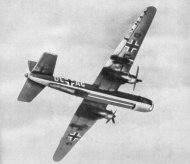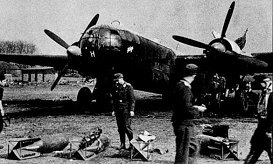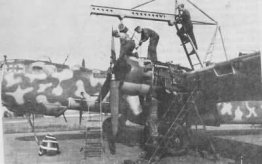
Heinkel He 177 Greif
Things started to go wrong at an early stage in the He 177's development. First the advanced cooling system for the twin engine installations was abandoned in favour of bigger radiators. This increased drag, however, and so more fuel was needed and the fuselage had to be strengthened, which made the aircraft heavier and reduced performance.
Then the remotely-controlled defensive armament was replaced by manned gun positions, adding more weight. And to meet the requirement for 60 degree diving attacks, further strengthening was required, which increased the weight still further.
Many prototypes were lost during test flights as a result of structural failure or engine fires. In service, take-offs proved tricky and led to several more accidents. More operational aircraft were lost to engine fires than to combat.
Attempts to cure the aircraft's faults were never successful. Even so, more than 1,000 of the various models were converted to prototypes of the He 277, with four separate engines each driving its own propeller and a single prototype of the improved four-propeller He 274 was completed by Farman in France and flown in December 1945.
Germany's only wartime heavy bomber, the He 177 was also one of its most troublesome aircraft. It was designed to use two pairs of engines, each driving a single propeller, to have three remotely controlled gun positions. Predicted performance figures included a top speed of 550 km/h (341 m.p.h) and a range of 6,700 km (4,150 mi) with a 1,000 kg (2,200 lbs) bombload, but the He 177 was never completely successful in service.
 |
 |
 |
| Of 35 He 177A-0 aircraft built, 25 were destroyed in accidents or fires. At least seven crashed while taking off. |
As a heavy bomber the Greif was used only to a limited extent and it is best remembered as an anti-shipping aircraft equipped with guided air-to-surface missiles, torpedos and bombs. |
Combining two DB 601 engines to produce the DB 606 unit produced a high degree of complexity in the He 177. This was magnified by the way the engine was installed, which made it prone to fire. |
|
Heinkel He 177 Greif (Technical Specification) |
| Role |
Heavy bomber, reconnaissance and anti-shipping aircraft |
| Manufacturer |
Heinkel |
| Maximum Speed |
488 kmh (303 mph) |
| Maximum range |
5,500 km (3,400 miles) |
| Ceiling |
8,000 meters (26,250 feet) |
Weight
Empty
Maximum Takeoff |
16,800 kg (39,960 lbs)
31,000 kg (68,200 lbs) |
Dimensions
Wingspan
Length
Height
Wing Area |
31.44 meters (103 ft 2 in)
22.00 meters (72 ft 2 in)
6.39 meters (20 ft 11 in)
102.00 square meters (1,098 sq ft) |
| Engines |
Two Daimler-Benz DB 610 24-cyclinder liquid cooled engines which provides 2,200 kW (2,950 hp) |
| Armament |
Two 20 mm (0.79 in) cannon
Three 7.9 mm (0.31 in) and three 13 mm (0.51 in) machine guns, up to 1,000 kg (2,200 lbs) in the bomb bay plus two missiles under the wings |
Photo Gallery
Click here to submit your photo
| Have A Passion For Aircraft? |
Subscribe to our 14 series FREE newsletter
delivered weekly on World War 2 Aircraft factfile... |
| NB:- We hate spam as much as you do, so your email address will NEVER be shared with or sold to anyone else. That's a Guarantee. |
|
|








